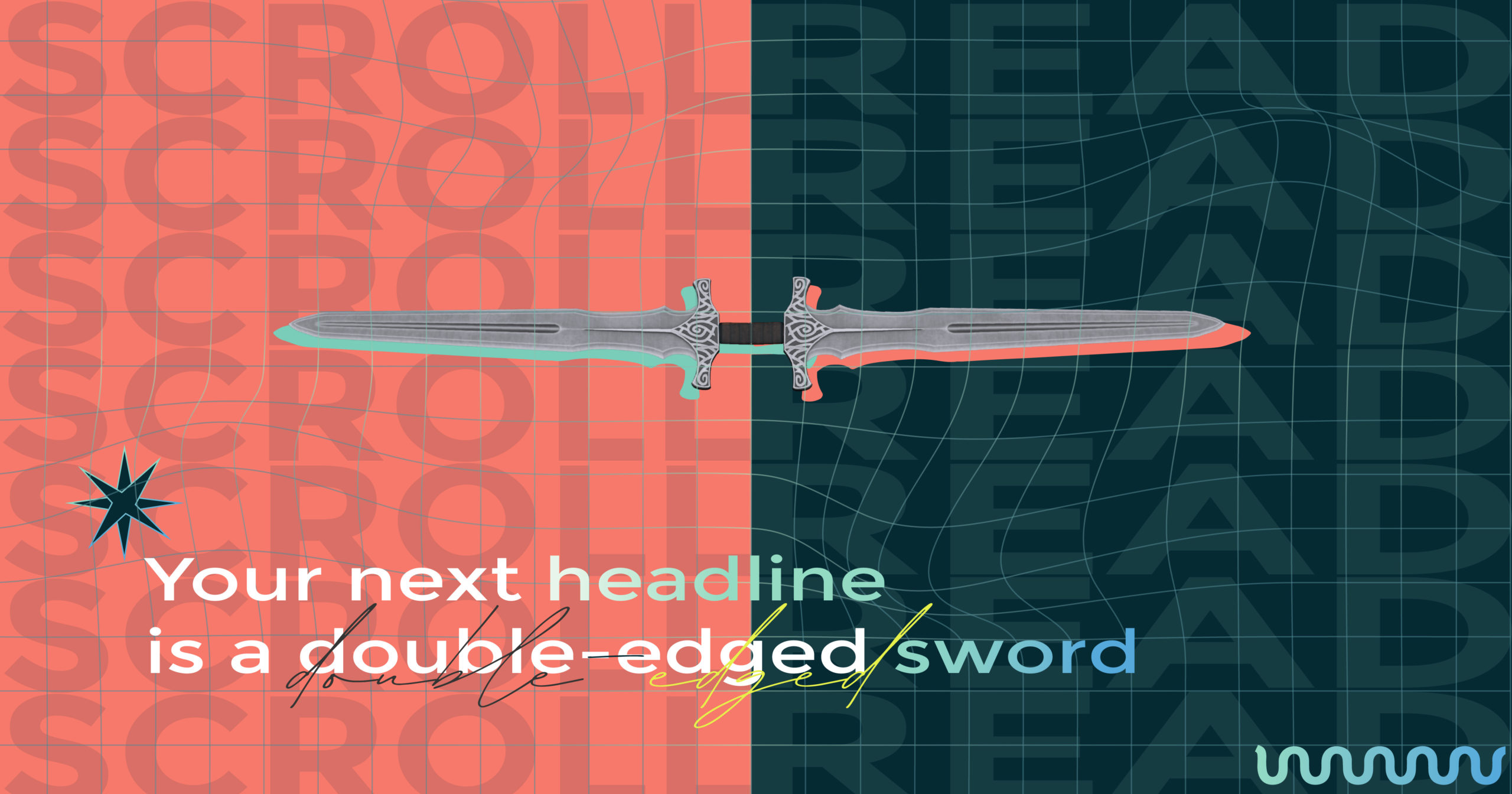
Your Next Headline Is a Double-Edged Sword
Headless body in topless bar.
If you think headlines can not be as effective as poetry, read the previous sentence again. It refers to the New York Post’s famous headline about a homicide in a striptease club almost 40 years ago. And it often serves as a blatant example of the unreal power that headlines have if appropriately crafted. But we’ll talk more about that later.
The form of headlines may have changed over time, but the essence remains the same. The headline language is concise, dense, and sharp. The words bring the crucial elements of the story to the forefront, and the grammar and syntax drum up the vigor.
Attention is the first association of headlines. The neck-grabbing one. Headlines are considered the ultimate awareness tool. But using them for one purpose only is a shameful undervalue of their potency.
Probably every marketer or product expert knows the importance of creating an impactful headline for a blog post, product sheet, e-mail, or any other piece of content. And many spend a lot of time weighing the most suitable headline.
Which powerful action verbs to use, how many characters are optimal for the best CTR, which trendy catchphrase will perform better, how to arrange keywords in the first half of the headline, and so on. Also, publishing an article without A/B headline testing is unimaginable. Even average marketers wouldn’t do it.
Still, not many understand the genuine power of headlines in full. While insights and metrics are essential when you tailor the text title, focusing only on these things can damage your article. And if it harms the content, it will inevitably negatively affect the goal of your writing in the first place.
Here is a breakdown of often neglected headline functionalities and quick guidelines on using them to their full potential.
Function 1: Contextualizer
Perceiving headlines as attention grabbers only creates a mental model of an article and its headline as two separate entities. This model considers a headline useless after leading a reader to the first sentence.
But, the truth is that every sentence in an article can be read only through the headlines’ lens. Your headline is the north star of the entire article. It kick-starts the cognitive process and frames the whole reading adventure.

The best way to understand the model is to imagine the opposite scenario — an article without the headline. The topic is unclear, and your focus is meandering with every read sentence. Context is absent. You are reading something but can not be fully immersed in the story. Sooner or later, you’ll quit.
People can’t function without frameworks. Headlines introduce and contextualize the story ahead. For instance, the headline of this article indirectly says: The following text covers how you may profit from suitably creating headlines. Or how you may be in danger if you act foolishly.
But with that differentiator in mind, readers will continue diving through the text and quickly notice and absorb the distinctions.
Function 2: Emotional calibrator
Emotional manipulation is something in which tabloids are matchless champions. By pedaling on FUD, anger, hatred, shock, tragedy, and horror, they put the readers in an emotional sub-spectrum of negative emotions. Why would they do it at all? To incentivize them to drive traffic by commenting, to impulsively purchase something, or — worst of all — to polarize people.
So, by calibrating emotions in our titles, we can influence or, in some cases, even determine readers’ future steps. Such a surreal and hair-raising power.
But as you can put readers in the dark, you can illuminate them with the same tool.
Once again, I will take the closest available example. A double-edged sword is a well-known metaphor that informs us things will go either good or ugly. And because a reader (and that’s you) is the protagonist in this story, they are in a conflict position. Or to say, the danger is upon you, dear reader.
To be righteous but also a cunning writer, I gave you the same amount of hope. So your starting position is a bittersweet symphony, but the last taste in your mouth relies only on your actions when crafting headlines in the future.
Function 3: The suspense generator
Headlines are cliffhangers. Why would anyone read the entire article if you said the whole point in your headline?
Let’s reflect on the example from the beginning — “headless body in topless bar.” Its rhyming aesthetics and attention-catching impact are masterful. But that is just the beginning.
With just five words, this title offers a complete story — a vivid motion picture appearing instantaneously in front of a reader’s eyes. You can imagine a vibrant atmosphere in the murk of the nightclub. You can smell the blood, hear sudden screams becoming louder and louder, see faces of frightened people stampeding around, and you surely can’t avoid trying to crack the puzzle. Who did this and why?
The headline becomes a mystery thriller. There’s no chance to read bits and pieces of the article. As a reader, you will be completely absorbed.
And now, a quick jump to your favorite example.
By using “double-edged sword” in the headline, I created suspense. Readers are expecting a bloodbath for sure, but who’s?. But who’s blood might it be? Mine or someone else’s? Let’s read on to find out.
Creating suspense has a flip side too.
Ironically, this blog post would be a disaster with no blood spilled. It would mean that I misinformed and deceived readers. It is like putting Checkov’s gun in a story and leaving it silent.
Such disappointment would fend off every reader from further consuming your content. Even a slight misinformation and divergence between the headline and the rest of the blog is something you can never play with if you want to stay credible and trustworthy.
So, by the rule of thumb, here are two simple yet unavoidable rules for creating suspense in headlines:
-
- Don’t put the punchline in your title but give a good-enough teaser.
- The truth is a must.
Function 4: Memory amplifier
Everything you have ever written will be forgotten at some point. Every blog post, case study, and e-mail. Sorry, people’s memories must get rid of anything unnecessary. But maybe, just maybe, you have a chance that fragments of your writings remain intact in someone’s memory. You know where this is going.
A series of experiments in 1997 showed that people have dramatically different capabilities in recalling memories of previously read articles. Surprisingly or not, the main memory differentiators aren’t text’s quality, structure, pompous words, sentences, or anything similar.
Headlines are the game-changers. They directly affect what and how readers will remember. If a headline points to crucial data or the conclusion from the text, that will survive in readers’ minds. On the other hand, if a headline is tailored to only catch attention, probably nothing will be remembered.
To sum things up, headlines change the way people remember articles. What do I want my customers to remember a year after reading this blog post? That’s the essential question before you start writing.

The headline mastering — Become a knight
With the triumph/disaster dichotomy overhanging every next content piece you write, it’s easy to conclude you have no choice but to become a skillful warrior to survive.
David Ogilvy, the unquestionable father of advertising, famously said:
On average, five times as many people read the headline as the body copy. When you have written your headline, you have spent eighty cents out of your dollar.
Like the old sharp-witted advertiser argues, the view through the money prism is probably the most straightforward way to grasp the importance of awesome headlines.
So, start practicing. Write, rewrite, discard, and repeat. Soon, you’ll become more confident when swinging the sword.


